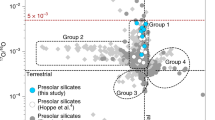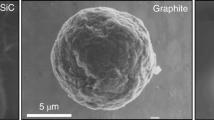Abstract
A SMALL number of intrinsically luminous, low-mass stars have recently been shown to have an extremely peculiar elemental abundance pattern. Their photospheric carbon, nitrogen, oxygen and sulphur abundances are within an order of magnitude of solar values, but all other normally abundant metals are present in only trace amounts; in two stars, iron is deficient by nearly five orders of magnitude. Two possible explanations are that the low iron content is primordial, implying a very great age, whereas the CNO and S abundances have been acquired during evolution, or that the CNO and S abundances reflect the initial stellar composition and the low iron content is the result of chemical separation by dust formation. The latter hypothesis arises mainly because the abundance pattern of these stars is similar to that of interstellar gas1, in which fractionation to dust plays an important part, but it is not easily understood how a process that must occur in the circumstellar envelope can so strikingly affect the photospheric abundances. Here we report the detection of appreciable amounts of zinc in the star HD52961, and argue that, because zinc will condense into dust only at rather low temperatures, its detection in near normal amounts is convincing evidence for the fractionation hypothesis.
This is a preview of subscription content, access via your institution
Access options
Subscribe to this journal
Receive 51 print issues and online access
$199.00 per year
only $3.90 per issue
Buy this article
- Purchase on Springer Link
- Instant access to full article PDF
Prices may be subject to local taxes which are calculated during checkout
Similar content being viewed by others
References
Venn, K. A. & Lambert, D. L. Astrophys. J. 363, 234–244 (1990).
Kodaira, K., Greenstein, J. L. & Oke, J. B. Astrophys. J. 159, 485–512 (1970).
Lambert, D. L., Hinkle, K. H. & Luck, R. E. Astrophys. J. 333, 917–924 (1988).
Bond, H. E. in Evolution of Stars: The Photospheric Abundance Connection (eds Michaud, G. & Tutukov, A.) 341–346 (Kluwer, Dordrecht, 1991).
Lamers, H. J. G. L. M. et al. Astr. Astrophys. 154, L20–L23 (1986).
Waelkens, C. et al. Astr. Astrophys. 251, 495–504 (1991).
Cohen, M. et al. Astrophys. J. 196, 179–189 (1976).
Waelkens, C. et al. Astr. Astrophys. 256, L15–L18 (1992).
Bond, H. E. & Luck, R. E. Astrophys. J. 312, 203–212 (1987).
Tielens, A. G. G. M. in From Miras to Planetary Nebulae: Which Path for Stellar Evolution? (eds Mennessier, M. O. & Omont, A.), 186–200 (Editions Frontières, Paris, 1990).
Harris, A. W. & Mas Hesse, J. M. Mon. Not. R. astr. Soc. 220, 271 (1986).
Van Steenberg, M. E. & Shull, J. M. Astrophys. J. 330, 942–963 (1988).
Jenkins, E. B. in Interstellar Processes (eds Hollenbach, D. J. & Thronson, H. A. Jr) 533–560 (Astrophysics and Space Science Library, Reidel, Dordrecht, 1987).
Phillips, A. P., Gondhalekar, P. M. & Pettini, M. Mon Not. R. astr. Soc. 200, 687 (1982).
Charbonneau, P. Astrophys. J. 372, L33–L36 (1991).
Gustafsson, B. in ESO Workshop on Stellar Evolution and Dynamics in the Outer Halo of the Galaxy (eds Azzopardi M & Mateucci, F.) 33–45 (1987).
Magain, P. Astr. Astrophys. 179, 176–180 (1987).
Author information
Authors and Affiliations
Rights and permissions
About this article
Cite this article
Winckel, V., Mathis, J. & Waelkens, C. Evidence from zinc abundances for dust fractionation in chemically peculiar stars. Nature 356, 500–501 (1992). https://doi.org/10.1038/356500a0
Received:
Accepted:
Issue Date:
DOI: https://doi.org/10.1038/356500a0
This article is cited by
-
An oxygen-rich dust disk surrounding an evolved star in the Red Rectangle
Nature (1998)
-
Binarity of the red-rectangle and other extremely fe-poor (post?)-AGB stars
Astrophysics and Space Science (1995)
-
Stellar evolution and mass loss on the asymptotic giant branch
Astrophysics and Space Science (1995)
-
A case of missing metals
Nature (1992)
Comments
By submitting a comment you agree to abide by our Terms and Community Guidelines. If you find something abusive or that does not comply with our terms or guidelines please flag it as inappropriate.



